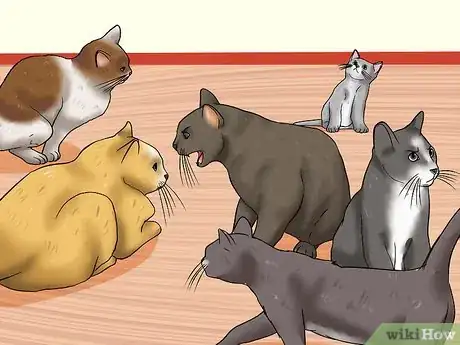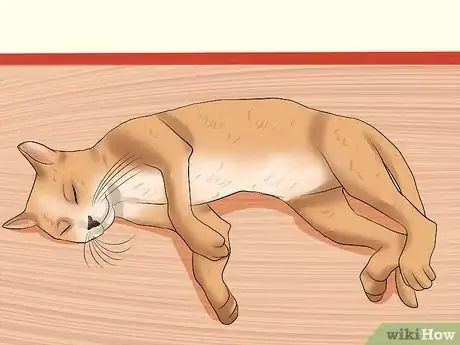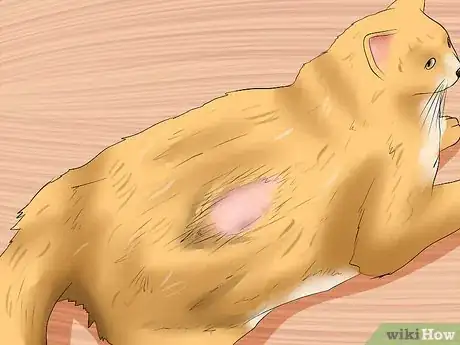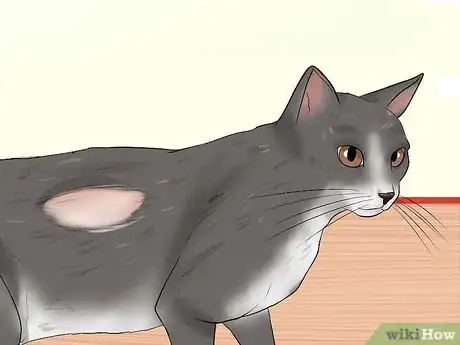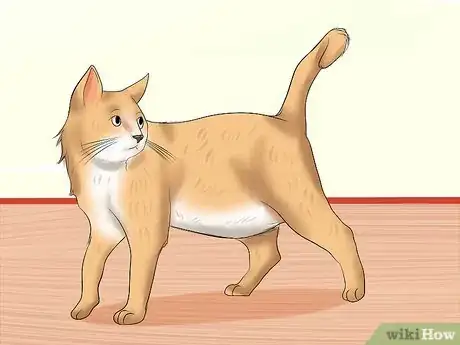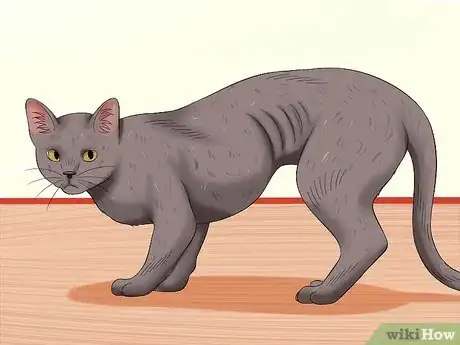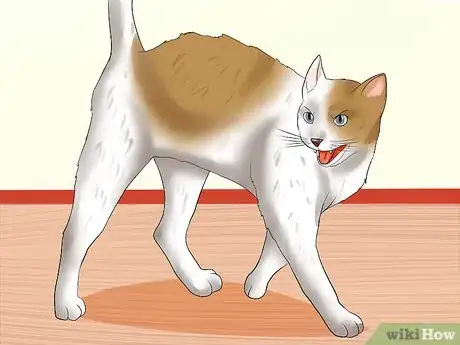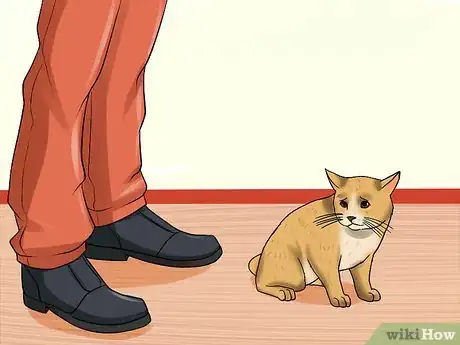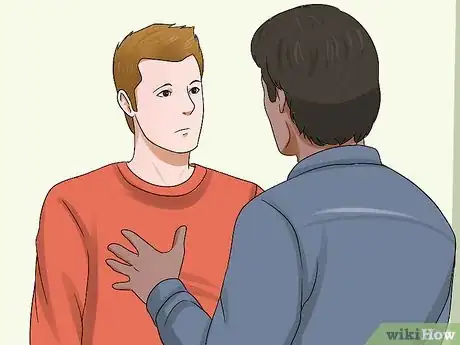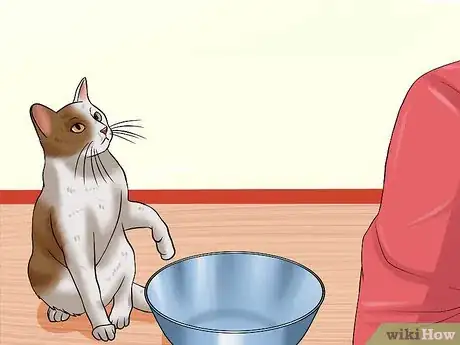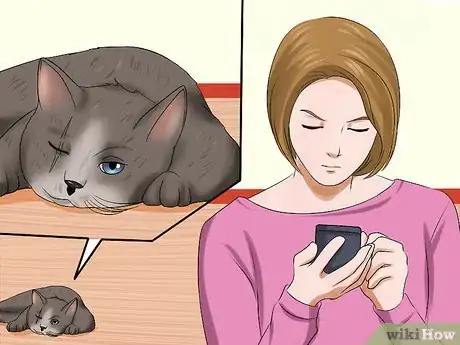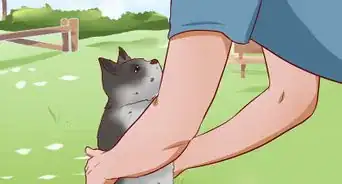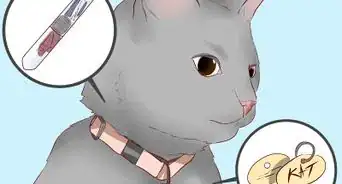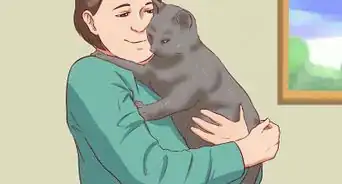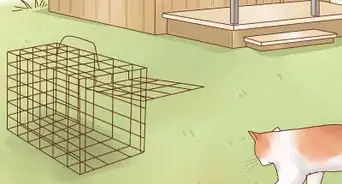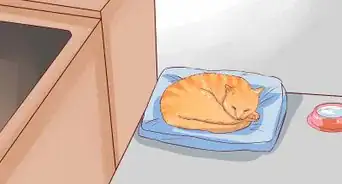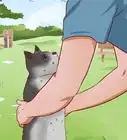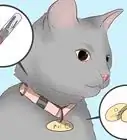This article was co-authored by Pippa Elliott, MRCVS. Dr. Elliott, BVMS, MRCVS is a veterinarian with over 30 years of experience in veterinary surgery and companion animal practice. She graduated from the University of Glasgow in 1987 with a degree in veterinary medicine and surgery. She has worked at the same animal clinic in her hometown for over 20 years.
wikiHow marks an article as reader-approved once it receives enough positive feedback. In this case, 89% of readers who voted found the article helpful, earning it our reader-approved status.
This article has been viewed 213,608 times.
When you picture abuse, it probably involves primarily physical violence. However, abuse can take many forms, and not all of them have obvious physical signs. In order to spot cat abuse, you must make sure that you can identify the signs of cat abuse, and that you understand the different kinds of abuse that are possible.
Things You Should Know
- Cat hoarding, neglect, injuries, illnesses, and repeat pregnancies are all signs of cat abuse.
- Have a casual conversation with the cat owner to see how the cat behaves around them and to learn if the cat has suffered accidental illness or injury.
- Report suspected abuse to your local law enforcement agency or animal welfare organization.
Steps
Signs of Abuse
-
1Look for signs of cat hoarding. Cat hoarders are a type of unintentional abuser, because they keep their cats in overcrowded and unsanitary living conditions. Overcrowding stresses the cats and forces large numbers of cats to live in a space that they would not normally occupy. This leads to bullying and extreme competition for resources, even if food is freely available, because some cats will be more dominant than others and guard the food.[1]
- The hoarder's environment is also usually dirty, lacking a clean place for the cats to sleep, eat, and use the toilet.
- Hoarders are often reluctant to receive visitors and act secretively, but the cats are usually easy to spot through the window.
-
2Pay attention to cats that do not have their basic needs met. Every pet cat has a right to shelter from the wind, rain, sun, and cold, as well as adequate food, fresh water, and sanitation.[2] If these basic principles are not met, it is considered abuse, and can be identified with the following signs:
- A painfully thin cat may not have enough food to eat.
- A fainting or very thirsty cat may not have enough water or shade.
- An antisocial or aggressive cat may have been taken away from his mother prematurely.
- A cat that is shut in a small space with no ability to play or fulfill her need for movement.
- A cat that is deprived of companionship or forced to live in an environment with loud music or constant shouting.
- A cat that does not have a litterbox or access to the outdoors while the owner is away.
Advertisement -
3Spot poor skin, coat, and paw condition. The cat may have hair loss, open sores, or an angry red rash. The cat's coat may be excessively matted, or infested with fleas and ticks. This can cause the cat to scratch himself raw, or have lots of black, coal-like dust mixed in with her hairs ("flea dirt").[3]
- Dab the dirt with a damp cotton towel. A orangey-red stain is blood that indicates a flea infestation.
- A cat with a tick infestation has lots of grey "bubbles" stuck to his skin, which are the engorging ticks.
- The cat may have overgrown nails that dig into the pads and cause the pads to bleed, or weep pus from an infection.
-
4Notice untreated wounds at risk of fly strike. An untreated open wound on a neglected cat is at risk of "fly strike." This means that flies may lay their eggs in the skin, which then hatch out into maggots. If this has already happened, you may notice cream-colored grubs wriggling in the wound, or a sickly sweet smell from the infected wound.
- Depending on how much they have fed, the maggots range in size from approximately a hair's width and half a millimeter (1/5 inches) long, to chunky grubs.
-
5Keep an eye out on any neighborhood cat that is repeatedly pregnant. Repeated pregnancy is also a form of neglect, because letting a female cat produce litter after litter puts a huge drain on the queen's body.
- Breeding is especially irresponsible if the kittens then mysteriously disappear, or populate the neighborhood with unwanted cats.
-
6Look for any cats that are especially thin or bony. Young or middle aged cats should be plump or sleek, with well-covered bones.[4]
- If you stroke a cat and his backbone bumps against your fingers, or if you can easily count each of his ribs, then the cat is underweight.
-
7Look for suspicious injuries to identify intentional abuse. Look for any cats that seem to be regularly injured, cut, or lame. A cat that favors a different leg on different days is especially suspicious, as this is likely caused by repeated injury rather than a chronic medical condition.[5]
- If you witness the owner in the act of physically abusing a cat, record the time and details and contact the police.
-
8Pay attention to odd behavior. Most animals that are being abused give tell-tale signs in their behavior.
- Commonly, the cats are described as seeming "cowed", hunkering down with dilated eyes, glancing around for an escape route.
- Some cats become highly aggressive, and lash out at the slightest provocation, since they regard attack as the best form of defense.
-
9Report abuse to the authorities to stop it. Never confront the suspected perpetrator but report your suspicions to the authorities. A detailed description or evidence will get your farther than a hunch, so be specific.[6]
- These include the local law enforcement authority, animal welfare organization, animal control officer, SPCA, or the local animal shelter.
- Collect information such as dates and times that you think the abuse happened, and if possible, document the evidence with photos or videos.
Types of Abuse
-
1Realize that sometimes other ailments can be mistaken for signs of abuse. Make sure to consider the bigger picture before making a judgment call. Sometimes it can be easy to mistake an animal that is sick, but receiving veterinary treatment, for a pet that is being abused.
- For instance, an animal that is very thin may have a medical condition that is being managed, not starving from lack of food.
-
2Take note of how the animal reacts around his owner. The cat's behavior around his owner can be a good indicator of its feelings towards the owner.
- If the cat runs to greet his owner and rubs around his legs purring that is a good sign.
- If the cat flinches and cowers, it is possible he is being abused.
- Even this is not conclusive, especially if you witness the cat struggling due to being fed medication or given a bath.
-
3Strike up a non-confrontational conversation with the cat owner. To determine if there is a possible explanation for a cat in distress, simply approach the owner and ask gently. Ask him whether the cat is all right, and listen attentively to the answer.
- Try to keep your tone conversational.
- If the owner says the cat is on medical treatment, you can try asking which vet the cat is seeing.
- If you are not satisfied by the answer, do not confront the owner, but consider putting the problem in the hands of the authorities.
-
4Understand what constitutes unintentional abuse. Unintentional abuse is just what it sounds like, abuse that occurs due to inadequate care, but is not malevolent. Sadly, even people who consider themselves animal lovers can perpetrate unintentional abuse.
- This type of abuse typically involves failing to meet all the animals' basic needs, such as adequate food, clean water, a clean place to rest, and shelter from the elements.
- Unintentional abuse is common when people hoard more animals than they can care for, or when they neglect their cats by not providing adequate food while they are on holiday.
-
5Be aware of intentional abuse. Intentional abuse occurs when the owner knows that the animal is being harmed or injured, but does nothing about it. In the worst case, this can be intentional neglect with cruel intent, intentionally inflicting pain and suffering on the cat.
- Besides physical injury, intentional abuse includes not taking a sick cat to the vet or not treating a flea infected cat.
Expert Q&A
Did you know you can get expert answers for this article?
Unlock expert answers by supporting wikiHow
-
QuestionWhat can I do to prevent my cats from hurting themselves?
 Pippa Elliott, MRCVSDr. Elliott, BVMS, MRCVS is a veterinarian with over 30 years of experience in veterinary surgery and companion animal practice. She graduated from the University of Glasgow in 1987 with a degree in veterinary medicine and surgery. She has worked at the same animal clinic in her hometown for over 20 years.
Pippa Elliott, MRCVSDr. Elliott, BVMS, MRCVS is a veterinarian with over 30 years of experience in veterinary surgery and companion animal practice. She graduated from the University of Glasgow in 1987 with a degree in veterinary medicine and surgery. She has worked at the same animal clinic in her hometown for over 20 years.
Veterinarian Cats don't intentionally hurt themselves, but can overgroom to the point of damaging their skin. It's important you look for the trigger that makes the cat feel the need to groom so excessively. This could be due to itchy skin as a result of parasites or an allergic reaction, or in some cases it is down to stress and the cat licks as a way of comforting herself.
Cats don't intentionally hurt themselves, but can overgroom to the point of damaging their skin. It's important you look for the trigger that makes the cat feel the need to groom so excessively. This could be due to itchy skin as a result of parasites or an allergic reaction, or in some cases it is down to stress and the cat licks as a way of comforting herself. -
QuestionWhat do I do for an abused cat that been rescued? It just hides out.
 Pippa Elliott, MRCVSDr. Elliott, BVMS, MRCVS is a veterinarian with over 30 years of experience in veterinary surgery and companion animal practice. She graduated from the University of Glasgow in 1987 with a degree in veterinary medicine and surgery. She has worked at the same animal clinic in her hometown for over 20 years.
Pippa Elliott, MRCVSDr. Elliott, BVMS, MRCVS is a veterinarian with over 30 years of experience in veterinary surgery and companion animal practice. She graduated from the University of Glasgow in 1987 with a degree in veterinary medicine and surgery. She has worked at the same animal clinic in her hometown for over 20 years.
Veterinarian In terms of attention, less is more for an abused cat. Make the home a safe, cat-friendly place with food, water, a clean litter box, toys, and hiding places. Avoid loud music or shouting so she starts to feel safe and trust you. Avoid making direct eye contact with her, and try lying on the floor so that you are a less intimidating size for her. Let her come to you, rather than approaching her. When she feels ready and able to trust you, she will start to venture out.
In terms of attention, less is more for an abused cat. Make the home a safe, cat-friendly place with food, water, a clean litter box, toys, and hiding places. Avoid loud music or shouting so she starts to feel safe and trust you. Avoid making direct eye contact with her, and try lying on the floor so that you are a less intimidating size for her. Let her come to you, rather than approaching her. When she feels ready and able to trust you, she will start to venture out.
References
- ↑ https://petsforpatriots.org/11-signs-of-animal-cruelty-and-how-you-can-help/
- ↑ https://petsforpatriots.org/11-signs-of-animal-cruelty-and-how-you-can-help/
- ↑ https://www.cathealth.com/cat-care/how-to/2255-animal-cruelty-signs-and-prevention-of-cruelty-to-cats
- ↑ https://www.animalkind.com/blog/how-to-spot-animal-abuse-and-how-you-can-help/
- ↑ https://www.animalkind.com/blog/how-to-spot-animal-abuse-and-how-you-can-help/
- ↑ https://www.animalkind.com/blog/how-to-spot-animal-abuse-and-how-you-can-help/
About This Article
To spot the signs of cat abuse, look for physical signs of neglect, like weight loss, visible bones, poor skin and coat quality, matted fur, and open sores. You should also keep an eye out for unintentional abuse, such as hoarding, which is when cats are kept together in overcrowded and unsanitary living conditions. If you suspect that a cat is being abused, avoid talking to the abuser directly since they may become confrontational. Instead, report your suspicions by calling your local animal control agency. For more advice from our Veterinary co-author, like how to spot signs of abuse in a cat’s behavior towards humans, keep reading.
